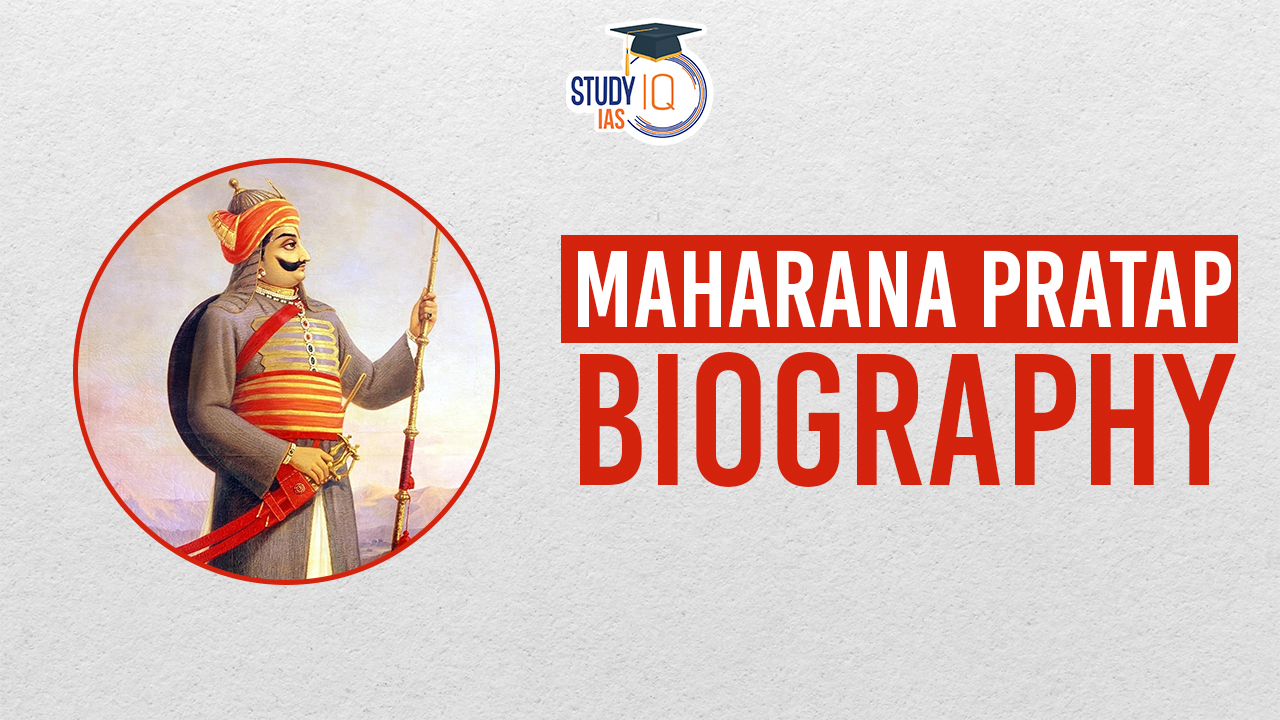Table of Contents
Maharana Pratap Biography: Maharana Pratap (1540-1597) was a valiant Rajput warrior and the 13th ruler of the Mewar region in Rajasthan, India. He is best remembered for his fierce resistance against the Mughal emperor Akbar during the latter half of the 16th century. Here is a brief biography of Maharana Pratap:
We’re now on WhatsApp. Click to Join
Maharana Pratap Early Life
Born on May 9, 1540, in the fortress of Kumbhalgarh, situated in the rugged terrain of Rajasthan, Maharana Pratap emerged as the scion of the illustrious Sisodiya Rajput lineage. His esteemed parents were Maharana Udai Singh II, the ruler of Mewar, and Rani Jeevant Kanwar. As the eldest son, Pratap held the pivotal position of Crown Prince, foretelling his destiny as the 54th ruler of the principality.
| Aspect | Details |
| Wife | Maharani Ajabde |
| Children | Amar Singh I, Bhagwan Das |
| Date of Birth | May 9, 1540 |
| Birthplace | Kumbhalgarh, Rajasthan |
| Death Date | January 29, 1597 |
| Death Place | Chavand |
Chittor’s Siege (1567)
In 1567, the young Maharana Pratap, at the age of 27, confronted a critical juncture when Chittor, Mewar’s capital, faced encirclement by the formidable Mughal forces commanded by Emperor Akbar. Despite his fervent desire to directly face the Mughals in defense of his realm, Pratap heeded the counsel of his elders, particularly his father Maharana Udai Singh II. The decision was made to evacuate Chittor, with the royal family relocating to the fortress of Gogunda.
Establishment as Maharana (1572)
The turning point in Maharana Pratap’s life occurred in 1572 with the demise of his father, Maharana Udai Singh II. This event marked Pratap’s ascension to the throne as the Maharana of Mewar. However, the intricacies of succession unveiled a challenge, as the influence of the late Maharana Udai Singh II favored Jagmal, Pratap’s half-brother, as the successor. This initial twist of fate tested the mettle of Pratap’s determination and leadership.
Pratap, initially adhering to his father’s wishes, supported Jagmal’s claim to the throne. However, recognizing the potential repercussions for Mewar’s stability, the nobles, notably the Chundawat Rajputs, persuaded Jagmal to relinquish his claim in favor of Pratap Singh. Thus, Maharana Pratap officially assumed the mantle as the 54th ruler of Mewar, setting the stage for his enduring legacy.
This intricate journey, marked by birthright, familial dynamics, and the weight of responsibility, laid the foundation for Maharana Pratap’s unwavering commitment to defending Mewar against external forces, particularly the Mughals led by Emperor Akbar.
Battle of Haldighati (1576)
The Battle of Haldighati in 1576 stands as a pivotal moment in Maharana Pratap’s life and in the history of Mewar. Fought against the Mughal forces led by Akbar’s general, Man Singh I, and his son, Prince Salim (later Emperor Jahangir), this battle showcased the indomitable spirit of Maharana Pratap.
Despite being outnumbered and facing significant odds, Maharana Pratap displayed extraordinary bravery on the battlefield. The Haldighati terrain, characterized by its narrow defiles and steep slopes, favored the Mughal cavalry, putting the Rajput forces at a disadvantage. Pratap’s horse, Chetak, became legendary for its loyalty and sacrifice during this intense encounter.
While the Mughals claimed victory in the battle, Maharana Pratap managed to escape, preserving himself to continue the resistance against the Mughal rule.
Maharana Pratap’s Life in Exile
Following the Battle of Haldighati, Maharana Pratap shifted his focus to guerrilla warfare tactics from the sanctuary of the Aravalli hills. Choosing the rugged and challenging terrain as his battleground, he waged a relentless struggle against the Mughals, refusing to submit to foreign rule.
Living in the jungles, Maharana Pratap found solace and support from his loyal followers, particularly the Bhils, who became an integral part of his resistance movement. The jungles served as a strategic refuge for Pratap, enabling him to regroup, plan, and launch surprise attacks against the Mughal forces.
Death of Maharana Pratap
Despite facing numerous challenges and being unable to reclaim his capital, Chittorgarh, Maharana Pratap’s unwavering commitment to the cause persisted. He breathed his last on January 19, 1597, within the walls of Chavand, a fort nestled in the Aravalli Range. His death marked the end of a life dedicated to the defense of Mewar’s sovereignty and the resistance against foreign domination.
Legacy of Maharana Pratap
Maharana Pratap’s legacy transcends his lifetime, resonating in the cultural and historical fabric of Rajasthan. Celebrated as a symbol of courage, chivalry, and the indomitable Rajput spirit, his life and exploits are woven into the rich tapestry of folklore, ballads, and historical accounts.
The enduring legacy of Mewar’s heroic ruler extends beyond the boundaries of time, serving as an inspiration for generations. Maharana Pratap’s valor and determination in the face of adversity continue to be celebrated, reinforcing his status as a revered figure in the annals of Rajput history and Indian folklore.
Maharana Pratap Jayanti
Maharana Pratap Jayanti, celebrated on May 9 Every Year, honors the 13th King of Mewar, renowned for his bravery against the Mughals. Born on May 9, 1540, Maharana Pratap faced numerous wars and notably fought in the Battle of Haldighati. Although he ultimately retreated, his valor earned him respect. Commemorated on the third day of the Jyeshtha Shukla phase in the Hindu calendar, this festival pays tribute to his role in instigating India’s first war of independence.
Maharana Pratap Biography UPSC
Maharana Pratap (1540-1597), the valiant 13th ruler of Mewar in Rajasthan, resisted Mughal emperor Akbar. Born on May 9, 1540, in Kumbhalgarh, he faced Chittor’s siege in 1567 but evacuated on advice. After Udai Singh II’s death in 1572, Pratap ascended, overcoming initial succession challenges. The Battle of Haldighati in 1576 showcased his bravery against Mughals, despite their claimed victory. Pratap’s guerrilla warfare in the Aravalli hills continued, supported by loyal followers like the Bhils. He died on January 19, 1597, in Chavand, leaving a legacy of courage and resistance against foreign rule in Rajasthan’s folklore and history.


 Sir Shankaran Nair and Story of the Jall...
Sir Shankaran Nair and Story of the Jall...
 Jyotiba Phule Biography, Facts and Socia...
Jyotiba Phule Biography, Facts and Socia...
 Veer Baburao Pullesur Shedmake: The Forg...
Veer Baburao Pullesur Shedmake: The Forg...





















